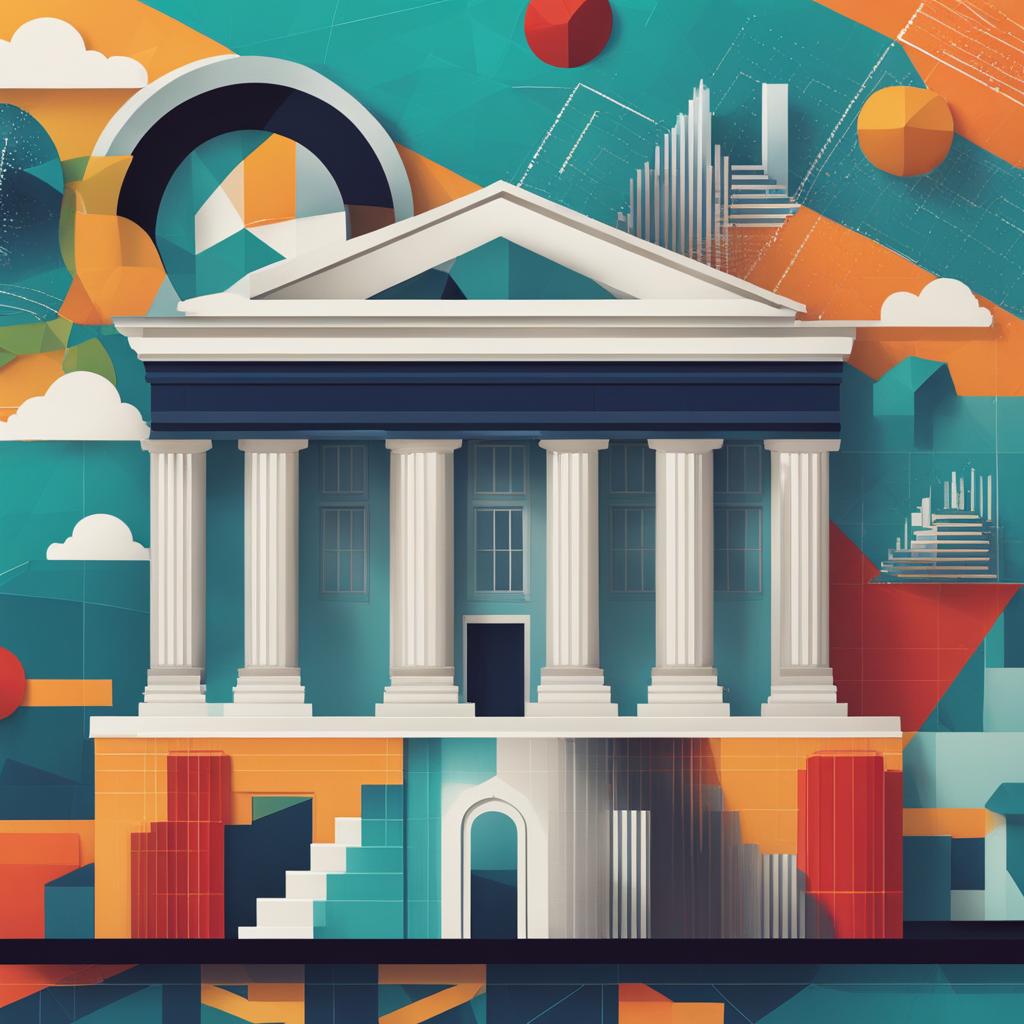Welcome to my comprehensive guide to the best national banks in the United States for 2024. In this article, I will provide an overview of the top national banks, compare their offerings, and help you find the best bank for your specific financial needs. Whether you’re looking for the best bank for savings, the best national bank for mortgages, or the best national bank for small businesses, I’ve got you covered!
Key Takeaways:
- Choosing the right national bank is crucial for your financial needs in 2024.
- Consider factors such as savings rates, customer service, and product offerings when selecting a national bank.
- Do thorough research and read national bank reviews to make an informed decision.
- Top national banks may offer competitive rates on savings accounts, mortgages, and services for small businesses.
- Remember to evaluate your specific needs, such as accessibility, fees, and account features, before deciding on the best national bank for you.
What Does it Mean to be a National Bank?
In this roundup, national banks are defined as financial institutions with a presence in at least 15 states, including those with physical branches as well as online-only banks. This means that accounts at online banks are available to people in almost every state. For banks with branches, only those with at least 1,000 locations were considered.
Presence of National Banks in 15 States
| Bank Name | Number of States | Physical Branches | Online-Only Presence |
|---|---|---|---|
| Bank of America | 50 | 4,500+ | No |
| JPMorgan Chase | 49 | 4,700+ | No |
| Citibank | 31 | 700+ | No |
| Wells Fargo | 39 | 5,400+ | No |
| Capital One | 49 | 500+ | No |
| Ally Bank | 50 | No | Yes |
| Discover Bank | 50 | No | Yes |
What Makes Big Banks Different from Smaller Banks?
When it comes to banking, there are various types of institutions available to cater to different needs. Big banks, regional banks, and community banks each offer their own unique advantages and characteristics. Understanding these differences is crucial in determining which type of bank is the best fit for you.
Big banks are national institutions that serve a larger portion of the country. They have a wide network of branches and ATMs, making them easily accessible to customers across multiple states. Big banks often provide a range of technologically advanced resources and a diverse selection of financial products and services.
On the other hand, regional banks typically operate within a specific geographical area, such as a few neighboring states. They may have fewer branches and ATMs compared to big banks, but they often offer a more localized approach to banking. With a focus on the specific needs of their regional customers, regional banks can provide a more personalized service experience.
Community banks are even more localized, serving a single city within a state or a specific neighborhood. These banks prioritize building strong relationships with their customers and are deeply rooted in their communities. Community banks are known for their exceptional personalized service, as they have a deep understanding of the local economy and the unique needs of the people they serve.
While big banks offer extensive resources and convenience, regional and community banks excel in providing personalized service and a more intimate banking experience. The decision of which type of bank to choose ultimately depends on your individual banking preferences and needs. It’s important to evaluate factors such as accessibility, available services, and the importance of personalized service when selecting a bank.
“Big banks offer extensive resources and convenience, while regional and community banks prioritize personalized service and a more intimate banking experience.”
In summary, big banks, regional banks, and community banks each have their own set of strengths and advantages. National banks provide extensive resources and a wide range of products, regional banks offer a more localized approach with personalized service, and community banks focus on building strong relationships within a specific community. Understanding these differences will help you make an informed decision when choosing the right bank for your financial needs.
How Much Interest Do the Best Big Banks Pay?
The best national banks, including both online and brick-and-mortar banks, offer various interest rates on savings products. However, it’s important to note that the best national banks don’t always have the highest interest rates compared to other banks.
Brick-and-mortar banks, even the best national ones, often pay around or below the national average for savings, which is currently at 0.46%. While these banks are well-established and offer convenient physical branches, their interest rates may not be as competitive as those of online banks.
On the other hand, online banks, including the best national ones, tend to offer higher Annual Percentage Yields (APYs) on savings accounts. These online banks leverage their lower operating costs to provide customers with better rates. As a result, individuals looking to maximize their savings through higher interest rates might find online banks, even among the best national ones, to be a more attractive option.
“While brick-and-mortar banks provide in-person accessibility, online banks often offer higher APYs, making them a favorable choice for those seeking better interest rates on savings accounts.”
By comparing the interest rates offered by different banks, individuals can make an informed decision and find a bank that aligns with their financial goals and preferences.
The table below compares the interest rates on savings accounts offered by the best national online banks and brick-and-mortar banks:
| Bank | Interest Rate on Savings Accounts |
|---|---|
| The Best National Online Bank | APY of 1.25% |
| The Best National Brick-and-Mortar Bank | APY of 0.30% |
As the table shows, the best national online bank offers a significantly higher APY compared to the best national brick-and-mortar bank. This demonstrates the potential for individuals to earn more interest on their savings by choosing an online bank.
To further explore the interest rates on savings accounts offered by different banks, it’s advisable to conduct thorough research and compare the rates provided by several financial institutions.

Are National Banks Better Than Other Kinds of Banks?
When it comes to choosing the right bank, the decision ultimately depends on individual preferences and needs. National banks, as well as other types of banking institutions, offer distinct advantages and disadvantages. Let’s take a closer look at the pros and cons of national banks to help you make an informed decision.
The Pros of National Banks
- National, brick-and-mortar banks provide in-person accessibility, making it easier for customers to visit a branch, speak to a banker, and handle financial transactions. This can be particularly beneficial for those who value face-to-face interactions and personalized customer service.
- Many national banks have a wide network of branches and ATMs across the country, ensuring convenience and accessibility no matter where you live or travel. This means you can easily access your funds and conduct transactions without worrying about limited physical locations.
The Cons of National Banks
- While in-person accessibility is a strength of national, brick-and-mortar banks, it can also be a limitation for those who prefer digital banking and have no need for physical branches. In such cases, online banks may offer better solutions, as they often provide higher interest rates and lower fees due to their lower operating costs.
- National banks may not necessarily offer the best rates for savings accounts, loans, or other financial products. Smaller, local banks and credit unions might provide more competitive rates, especially if you prioritize maximizing returns or minimizing costs.
“I appreciate being able to walk into my local bank and have a conversation with a banker who knows my name and understands my financial goals.”
However, it’s important to recognize that preferences vary from person to person, and what works for one individual may not be the best fit for another. Therefore, before making a decision, carefully consider your priorities and evaluate the pros and cons of different banking institutions.
Ultimately, national banks can be a great option for those who value in-person accessibility, a wide branch network, and a range of financial services. On the other hand, if you prioritize the best rates and the convenience of online banking, national online banks may better suit your needs.

In the end, the choice between national banks and other types of banks depends on your individual preferences and financial goals. By weighing the pros and cons, you can find the right banking institution that aligns with your needs and enhances your overall banking experience.
Are the Best National Banks Brick-and-Mortar Banks?
When it comes to the best national banks according to NerdWallet’s picks, they are not limited to brick-and-mortar establishments. In fact, many of the best national banks are online banks that offer more attractive deposit interest rates compared to their brick-and-mortar counterparts.
Online banks have gained popularity due to their convenience, accessibility, and competitive rates. They operate solely online, allowing customers to manage their accounts remotely through web and mobile platforms. These digital-focused banks often have lower overhead costs, which enables them to pass on the savings to customers in the form of higher interest rates.
However, it’s important to note that some brick-and-mortar banks still stand out for other reasons. For instance, they may offer sign-up bonuses or personalized customer service that resonates with certain individuals. In-person banking services can also be beneficial for those who prefer face-to-face interactions or access to physical branches.
If you prefer the convenience and higher deposit interest rates offered by online banks, they can be an excellent choice. On the other hand, if you value the benefits of signing up with a brick-and-mortar bank, it’s worth exploring the offerings of these institutions as well.
Ultimately, the best national bank for you will depend on your individual banking preferences and needs. It’s essential to weigh the benefits of both online and brick-and-mortar banks before making a decision.

Pros and Cons of Online Banks and Brick-and-Mortar Banks
| Online Banks | Brick-and-Mortar Banks |
|---|---|
| Higher deposit interest rates | In-person banking services |
| Convenience of 24/7 access | Face-to-face interactions |
| No location restrictions | Accessible physical branches |
| Lower fees and minimum balance requirements | Personalized customer service |
| Advanced online banking technology | Sign-up bonuses and promotions |
What Makes the Best National Brick-and-Mortar Banks Different from the Best National Online Banks?
The best national brick-and-mortar banks and the best national online banks have different strengths. Let’s take a closer look at what sets them apart:
Brick-and-Mortar Banks:
Brick-and-mortar banks are more likely to offer promotions or welcome bonuses for new accounts. These promotions can include cash rewards, waived fees, or even higher interest rates for a limited time. In-person accessibility is a notable advantage of brick-and-mortar banks, as they have physical branches where customers can speak directly with a banker, deposit or withdraw funds, and seek assistance for their banking needs.
Online Banks:
On the other hand, online banks generally offer higher Annual Percentage Yields (APYs) compared to their brick-and-mortar counterparts. This means that online banks can provide better interest rates on savings accounts and other deposit products. Online banks often have lower operating costs since they don’t have to maintain physical branches, allowing them to pass on the savings to their customers in the form of higher APYs. Additionally, online banks typically have large third-party ATM networks, enabling customers to conveniently access cash without having to rely solely on their bank’s own ATM network.
When deciding between the best national brick-and-mortar banks and the best national online banks, it’s essential to consider your preferences and banking needs. If you value in-person interactions and the convenience of physical branches, a brick-and-mortar bank may be the right choice for you. On the other hand, if you prioritize higher APYs and access to a vast network of ATMs, an online bank can provide the competitive rates and convenience you seek.

Is My Money Safer in a National Bank vs. a Regional Bank or Credit Union?
Your money is equally safe in any bank or credit union that is insured by the Federal Deposit Insurance Corporation (FDIC) or the National Credit Union Administration (NCUA).
As long as your bank or credit union has this protection, you are insured for up to $250,000 per person, per ownership category, per bank or credit union.
The level of safety is the same for both national and regional banks, as well as national and regional credit unions.
| Type of Institution | Insurance |
|---|---|
| National Bank | FDIC |
| Regional Bank | FDIC |
| National Credit Union | NCUA |
| Regional Credit Union | NCUA |
What is the No. 1 Bank in America?
When it comes to the largest bank in America based on asset size, Chase Bank takes the crown. With its extensive reach, Chase Bank has branches in almost every state across the country, providing a wide network of financial services. Additionally, it boasts an impressive number of ATMs, totaling around 16,000, ensuring convenient access to cash and banking services for its customers.
However, it’s essential to note that while Chase Bank may be the largest, it might not necessarily be the best choice for everyone. Factors such as interest rates, fees, and additional services play crucial roles in determining the right bank for your specific needs and preferences.
“The largest bank is not always the best option for all customers. It’s crucial to consider various factors, such as interest rates, fees, and additional services, when choosing a bank.”
By thoroughly evaluating these factors and comparing them with your personal requirements, you can make an informed decision on which bank aligns best with your financial goals. Remember, the aim is to find a bank that not only offers convenience in terms of branch locations and ATM access but also provides competitive rates and exceptional services tailored to your needs. So, take the time to weigh your options and make the right choice.
Continue reading to discover the bank that holds the highest customer satisfaction rating in specific regions across the United States.
Which Bank is the Best Rated in America?
When it comes to choosing a bank, customer satisfaction is a crucial factor to consider. According to the J.D. Power 2024 U.S. Retail Banking Satisfaction Study, two banks stand out for their exceptional ratings: Chase Bank and U.S. Bank.
Chase Bank has earned the title of the best-rated bank for customer satisfaction in the Upper Midwest, Mid-Atlantic region, and Florida. This recognition speaks to the excellent experience and service provided to customers in these areas.
On the other hand, U.S. Bank takes the lead in California, being the best-rated bank for customer satisfaction in the state. Their commitment to serving Californians and meeting their financial needs has been acknowledged and appreciated by customers.
Customer satisfaction is more than just a number; it reflects the overall experience individuals have with their banks. From addressing inquiries to handling transactions smoothly, these top-rated banks have consistently delivered exceptional service, earning the trust and loyalty of their customers.
When considering which bank to choose, it’s essential to prioritize customer satisfaction alongside other factors such as interest rates, fees, and account features. By selecting a bank with high ratings in customer satisfaction, you can ensure a positive banking experience that aligns with your needs and expectations.
The Importance of Customer Satisfaction
Customer satisfaction plays a pivotal role in the banking industry. Satisfied customers not only develop a sense of trust in their banks but also become advocates, recommending these institutions to others. Positive experiences foster long-term relationships and drive the success of banks.
Providing top-notch customer service is the foundation of a strong banking institution. By prioritizing customer satisfaction, banks can build lasting relationships and maintain a loyal customer base.
These exceptional ratings for Chase Bank and U.S. Bank highlight their commitment to meeting customer needs and delivering an outstanding banking experience. As you explore your options, consider placing customer satisfaction at the forefront with these top-rated banks.
What are the Top 10 Banks in the United States?
When it comes to choosing a bank in the United States, it’s essential to consider the top players in the industry. Based on the most recent Federal Reserve data, the following retail banks stand out as the top 10 banks in the country in terms of assets:
| Bank | Assets |
|---|---|
| Chase Bank | \$3.97 trillion |
| Bank of America | \$2.63 trillion |
| Wells Fargo | \$1.96 trillion |
| Citibank | \$1.76 trillion |
| U.S. Bank | \$534.7 billion |
| PNC Bank | \$474.4 billion |
| Goldman Sachs | \$423.0 billion |
| Truist Bank | \$403.3 billion |
| Capital One | \$342.7 billion |
| TD Bank | \$343.3 billion |
These top 10 retail banks not only have substantial assets but also possess large branch and ATM networks across the United States. They offer a wide range of financial products and services to meet different customer needs.
When choosing a bank, it’s important to consider individual priorities, such as interest rates, accessibility, and customer service. Evaluating these factors will help you make an informed decision on which bank aligns best with your financial goals and needs.
Which is Better: Chase vs. Wells Fargo? Wells Fargo vs. Bank of America?
When it comes to comparing banks like Chase, Wells Fargo, and Bank of America, the choice ultimately depends on your individual preferences and needs. Consider factors such as the specific services you rely on most frequently, the availability of branches and ATMs in your area, and other relevant aspects like interest rates and fees. To make an informed decision, take the time to research and compare the offerings of these different banks.
Services
One of the key aspects to consider is the range of services offered by each bank. Chase, Wells Fargo, and Bank of America all provide similar services, including checking and savings accounts, credit cards, and loans. However, they may differ in the specifics, such as the types of credit cards available or the features of their online banking platforms. Take a close look at the services offered to ensure they align with your financial needs.
Branches and ATMs
The availability of branches and ATMs is another important consideration. Chase, as one of the largest banks in the United States, has a wide network of branches and ATMs across the country. Wells Fargo and Bank of America also have significant branch and ATM coverage, but their availability may vary depending on your location. If access to physical locations is essential for your banking needs, evaluate which bank has the most convenient presence in your area.
Interest Rates and Fees
Interest rates and fees are crucial factors when choosing a bank. Compare the rates and fees associated with different types of accounts at Chase, Wells Fargo, and Bank of America to determine which bank offers the most favorable terms for your financial goals. Consider whether you prioritize high-interest savings accounts or low-fee checking accounts, and find the bank that aligns with your preferences.
Customer Service
The level of customer service provided by each bank is also worth considering. Look for feedback from existing customers to gain insights into the customer service experiences at Chase, Wells Fargo, and Bank of America. Online reviews and ratings can provide valuable information about the responsiveness and helpfulness of the bank’s customer support team.
| Chase | Wells Fargo | Bank of America | |
|---|---|---|---|
| Services | Checking, savings, credit cards, loans | Checking, savings, credit cards, loans | Checking, savings, credit cards, loans |
| Branches | 5,000+ | 5,200+ | 4,300+ |
| ATMs | 16,000+ | 13,000+ | 16,100+ |
| Interest Rates | Varies by account | Varies by account | Varies by account |
| Fees | Varies by account | Varies by account | Varies by account |
| Customer Service | 4/5 customer rating* | 3.8/5 customer rating* | 3.8/5 customer rating* |
Ultimately, the best bank for you will depend on your personal needs and preferences. Take the time to weigh the factors that are most important to you, such as services, branch coverage, interest rates, fees, and customer service. By thoroughly researching and comparing the offerings of Chase, Wells Fargo, and Bank of America, you can choose the bank that best meets your individual financial requirements.
*Customer ratings based on internal surveys and public reviews as of 2024.
Conclusion
After carefully evaluating the factors that matter most in choosing a national bank in the U.S., such as interest rates, fees, accessibility, and customer service, it is clear that making an informed decision is crucial. The best national bank for your needs will depend on your own priorities and preferences.
By conducting thorough research and comparing different banks, you can confidently select the one that aligns with your financial goals. Consider factors like the interest rates they offer, the fees associated with their services, how accessible their branches and ATMs are for your convenience, and the quality of their customer service.
Remember, choosing the best national bank is a personal decision that depends on your unique needs and circumstances. So take your time, assess your options, and make an informed choice that will help you achieve your financial aspirations. With the right bank by your side, you’ll have the necessary tools and support to manage your money effectively and reach your goals.
FAQ
What does it mean to be a national bank?
National banks are financial institutions with a presence in at least 15 states, which can include both physical branches and online-only banks.
What makes big banks different from smaller banks?
Big banks, also known as national banks, have a larger reach and serve a larger portion of the country compared to regional or community banks. They typically offer more technological resources and a wider variety of products, while smaller banks can provide more personalized service.
How much interest do the best big banks pay?
The best national banks, whether they are brick-and-mortar or online, often pay around the national average for savings, which is 0.46% or less. Online banks tend to have higher APYs (Annual Percentage Yields) than brick-and-mortar banks.
Are national banks better than other kinds of banks?
Whether national banks are better than other kinds of banks depends on individual preferences. National, brick-and-mortar banks are a good fit for those who prioritize in-person accessibility, while the best national online banks may be a good fit for those interested in the best rates and large ATM networks. It’s important to consider the pros and cons of different banking institutions when choosing a bank.
Are the best national banks brick-and-mortar banks?
No, many of the best national banks are online banks that offer better deposit interest rates compared to brick-and-mortar banks. However, some brick-and-mortar banks stand out for other reasons such as sign-up bonuses or customer service. It’s important to consider the offerings of both online and brick-and-mortar banks when choosing a bank.
What makes the best national brick-and-mortar banks different from the best national online banks?
Brick-and-mortar banks are more likely to offer promotions or welcome bonuses for new accounts, while online banks generally have higher APYs than their brick-and-mortar counterparts. Brick-and-mortar banks offer in-person accessibility, while online banks often have large third-party ATM networks. It’s important to consider the features and benefits of each type of bank when making a decision.
Is my money safer in a national bank vs. a regional bank or credit union?
Your money is equally safe in any bank or credit union that is insured by the Federal Deposit Insurance Corporation (FDIC) or the National Credit Union Administration (NCUA). The level of safety is the same for both national and regional banks, as well as national and regional credit unions. As long as your bank or credit union has this protection, you are insured for up to 0,000 per person, per ownership category, per bank or credit union.
What is the No. 1 bank in America?
Chase Bank is currently the largest bank in America based on asset size. It has branches in nearly all states and about 16,000 ATMs. However, the largest bank may not necessarily be the best choice for everyone. It’s important to consider factors such as interest rates, fees, and additional services when choosing a bank.
Which bank is the best-rated in America?
According to the J.D. Power 2024 U.S. Retail Banking Satisfaction Study, Chase Bank is the best-rated bank for customer satisfaction in the Upper Midwest, Mid-Atlantic region, and Florida. U.S. Bank is the best-rated bank for customer satisfaction in California. Customer satisfaction is an important factor to consider when choosing a bank, as it reflects the overall experience and service provided by the bank.
What are the top 10 banks in the United States?
According to the most recent Federal Reserve data, the top 10 retail banks in the U.S. based on assets are Chase Bank, Bank of America, Wells Fargo, Citibank, U.S. Bank, PNC Bank, Goldman Sachs, Truist Bank, Capital One, and TD Bank. These banks have large branch and ATM networks and offer a variety of products. It’s important to consider individual priorities such as interest rates and accessibility when choosing a bank.
Which is better: Chase vs. Wells Fargo? Wells Fargo vs. Bank of America?
The choice between banks like Chase, Wells Fargo, and Bank of America depends on individual preferences and needs. It’s important to consider factors such as the services you use most frequently, the availability of branches and ATMs in your area, as well as other relevant factors like interest rates and fees.
Our Friends
- https://www.businessinsider.com/personal-finance/best-national-banks
- https://money.com/best-national-banks/
- https://www.nerdwallet.com/best/banking/best-national-banks
Money posts:
 Best Online Banks of 2024
Best Online Banks of 2024
 9 Best Mobile Banking Apps for 2024 – Manage Your Money on the Go
9 Best Mobile Banking Apps for 2024 – Manage Your Money on the Go
 Axos Bank Review | Millennial Money (2024)
Axos Bank Review | Millennial Money (2024)
 Ally Bank Review – Complete Guide (2024)
Ally Bank Review – Complete Guide (2024)
 Merrick Bank Review 2024
Merrick Bank Review 2024
 12 Best Banks For Self-Employed Freelancers & Side Hustlers (2024)
12 Best Banks For Self-Employed Freelancers & Side Hustlers (2024)
 Opening an Online Bank Account: What You Need to Know (2024)
Opening an Online Bank Account: What You Need to Know (2024)
 12 Places to Get a Money Order Near Me (2024)
12 Places to Get a Money Order Near Me (2024)

